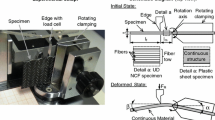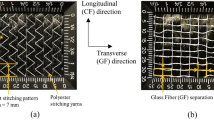Abstract
Various commercially available unidirectional (UD) non-crimp-fabrics (NCFs) are currently used for manufacturing carbon fiber reinforced plastic (CFRP) parts. These UD NCFs can differ significantly in their forming behavior. For optimizing and ensuring the manufacturability of the forming process of CFRP parts manufactured from UD NCFs these differences have to be taken into account. This motivates developing an efficient and universally applicable modular modeling approach for describing the in-plane forming behavior of various UD NCFs. The first component of this modular approach is a hyperelastic material model that accurately predicts the fiber orientation of UD NCFs during forming. This material model is implemented via a user-defined material subroutine in the commercial finite element package LS-DYNA. The second component is a simple truss structure that allows modeling the various stitch patterns of the different UD NCFs. This modular model can be calibrated via simple tensile tests. To demonstrate the versatility of this approach, the in-plane forming behavior of three different UD NCFs is validated by comparing experimental data and simulation results of the common picture frame test.













Similar content being viewed by others
References
Aimène Y, Vidal-Salle E, Hagege B, Sidoroff F, Boisse P (2010) A hyperelastic approach for composite reinforcement large deformation analysis. J Compos Mater 44:5–26
Badel P, Gauthier S, Vidal-Sallé E, Boisse P (2009) Rate constitutive equations for computational analyses of textile composite reinforcement mechanical behaviour during forming. Compos Part A Appl Sci Manuf 40:997–1007
Belytschko T, Liu WK, Moran B (eds.) (2009) Nonlinear finite elements for continua and structures. Wiley, Chichester and New York and Winheim and Brisbane and Singapore and Toronto
Boisse P, Zouari B, Daniel JL (2005) Importance of in-plane shear rigidity in finite element analyses of Woven fabric composite preforming. Compos Part A Appl Sci Manuf 37:2201–2212
Bonet J, Burton A (1998) A simple orthotropic, transversely isotropic hyperelastic constitutive equation for large strain computations. Comput Methods Appl Mech Eng 162:151–164
Cao J, Akkerman R, Boisse P, Chen J, Cheng HS, Graaf EFd, Gorczyca JL, Harrison P, Hivet G, Launay J, Lee W, Liu L, Lomov SV, Long A, Luycker Ed, Morestin F, Padvoiskis J, Peng XQ, Sherwood J, Stoilova T, Tao X, Verpoest I, Willems A, Wiggers J, Yu T, Zhu B (2008) Characterization of mechanical behavior of woven fabrics: experimental methods and benchmark results. Compos Part A Appl Sci Manuf 39:1037–1053
Duhovic M, Mitschang P, Bhattacharyya D (2011) Modelling approach for the prediction of stitch influence during woven fabric draping. Compos Part A Appl Sci Manuf 42:968–978
FORMAX: products: http://www.formax.co.uk/product.php?id=40&c=3&t=13
Gereke T, Döbrich O, Hübner M, Cherif C (2013) Experimental and computational composite textile reiforcement forming: a review. Compos Part A Appl Sci Manuf 46:1–10
Holzapfel GA (ed) (2010) Nonlinear solid mechanics: a continuum approach for engineering. Wiley, Chichester and New York and Winheim and Brisbane and Singapore and Toronto
Itskov M, Aksel N (2004) A class of orthotropic and transversely isotropic hyperelastic constitutive models based on a polyconvex strain energy function. Int J Solids Struct 41:3822–3848
Khan M, Mabrouki T, Gauthier S, Vidal-Sallé E, Boisse P (2008) Preforming simulation of the reinforcements of woven composites: continuous approach within a commercial code. Int J Mater Form 1:879–882
Livermore Software Technology Corporation: LS-DYNA theory manual, Version 2006 (2006)
Livermore Software Technology Corporation: LS-DYNA KEYWORD USER’S MANUAL VOLUME II, Version 971 (2012)
Lomov SV, Barburski M, Stoilova T, Verpoest I, Akkerman R, Loendersloot R, Thije Rt (2005) Carbon composites based on multiaxial multiply stitched preforms. Part 3: Biaxial tension, picture frame and compression tests of the preforms. Compos Part A Appl Sci Manuf 36:1188–1206
N.N.: DIN EN ISO 2062:2010–04: Textilien - Garne von Aufmachungseinheiten - Bestimmung der Hchstzugkraft und chstzugkraftdehnung von Garnabschnitten unter Verwendung eines Prfgerts mit konstanter Verformungsgeschwindigkeit (2010)
Roll K (2011) Application of virtual methods in automotive industry. In: RH Kolleck (ed) Tools and technologies for processing ultra high strength materials, Graz, pp 81–86
Sidhu R, Averill R, Riaz M, Pourboghrat F (2001) Finite element analysis of textile composite preform stamping. Compos Struct 52:483–497
Spencer A (1984) Continuum theory of the mechanics of fibre-reinforced composites. Springer, Berlin
Thije RHWt, Akkerman R, Huétink J (2007) Large deformation simulation of anisotropic material using an updated Lagrangian finite element method. Computer methods in applied mechanics and engineering 196:3141–3150
Wiggers J, Long AC, Harrison P, Rudd CD (2003) The effects of stitch architecture on the shear compliance of non-crimp fabrics. In: 6th international ESAFORM conference on materials forming 6:851–854
Yu WR, Harrison P, Long A (2005) Finite element forming simulation for non-crimp fabrics using a non-orthogonal constitutive equation. Compos Part A Appl Sci Manuf 36:1079–1093
Acknowledgments
The authors would like to thank Christian Keintzel, BMW Group, for interesting discussions and his support with the tensile tests.
Author information
Authors and Affiliations
Corresponding author
Rights and permissions
About this article
Cite this article
Senner, T., Kreissl, S., Merklein, M. et al. A modular modeling approach for describing the in-plane forming behavior of unidirectional non-crimp-fabrics. Prod. Eng. Res. Devel. 8, 635–643 (2014). https://doi.org/10.1007/s11740-014-0561-z
Received:
Accepted:
Published:
Issue Date:
DOI: https://doi.org/10.1007/s11740-014-0561-z




